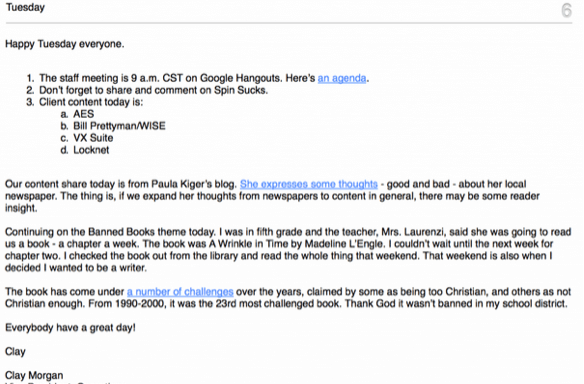When I first started at Arment Dietrich, they poked fun at me.
Then they mocked me.
(Editor’s note: To be fair, we still mock him.)
Occasionally I even mocked myself and wondered why I started it.
But then the habit formed and they accepted me.
I’m talking about a little internal communications practice I call “the morning email.”
It is pretty simple.
It’s an email I send to the entire Arment Dietrich team somewhere between 6 a.m. and 7 a.m. CT.
There’s nothing complicated in this approach to our internal communications, but I think it is extremely important to a company that is virtual.
What is in the Email?
I have the email broadly broken up into three parts.
Sometimes the emails are short, sometimes pretty lengthy. It just kind of depends on what’s going on that day.
The first part is reminders.
This is a bullet point list of things that should be on everybody’s agenda that day.
- Commenting on and sharing the Spin Sucks and client content.
- Don’t forget the staff meeting this morning.
- Your ideas for the prospective new client are due at 3:00 p.m. CT.
That sort of thing.
The second part is a content share. This is part of an ongoing effort to provide passive training to the team.
Usually it is a link, although occasionally I’ll tell a relevant story.
Sometimes it is industry specific, sometimes it is more in line with personal development or time management, or some other topic that is not specific to digital marketing, but will still help us do our jobs better.
The final piece is just a fun bit. It might be trivia or today in history.
Once, we reminded Laura Petrolino just how many Stephen King novels are set in Maine and that maybe she should move.
Nothing fancy, nothing complex, right?
So Why Do it?
There is an internal communications tool of which I am a huge proponent—the morning huddle.
Throughout my newspaper career, most departments had morning huddles—a five-minute meeting that was designed to highlight priorities for the day and let everyone know what everyone is working on.
We could do this on Google Hangouts easy enough, but there is an issue.
If we do it at 7:30 or 8:00 a.m. CT, early risers will already be a couple of hours into their day.
On the left coast, others of our team will still be asleep (or should be!).
As a virtual company spanning two countries, and literally one end of the United States to the other, time zones make such a meeting difficult.
Still, I needed a way to accomplish three things:
- Set a tempo for the day and get everyone on the same page.
- Remind everyone of those little things we all have to do, but are so easy to forget.
- Let everybody know I’m up and around, and it is game time.
There are some secondary benefits.
One is the content link does provide some degree of education or spur some creative thinking.
Also, the email sometimes results in information (or sometimes barbs) being passed back and forth (usually via email). It becomes an interactive tool.
That interactivity is the key to the email’s success.
The staff must be comfortable adding on their own reminders if I’ve forgotten something or was unaware of something.
They must also be okay contributing in other ways, even if “other ways” means a little cutting up.
Your Own Internal Communications
Even in a company where you want people working independently, this type of internal communications is important.
In addition to the various announcements, it reminds people there is a bigger picture and that they are part of a larger team.
Your approach is just that, your approach. You will need to decide what is best for your team.
A physical morning huddle or similar activity (I hate to call huddles meetings as that is not what I’m after) on Google Hangouts may be required.
Or it may be something different—an update on Facebook or your own email.
You may even decide that daily is not the right frequency. You may prefer weekly or twice a day.
It all depends on the needs of your company and your team.
Regardless, I think you’ll find if you start similar internal communications, and stick with it, it will develop into the backbone of your regular communication with your teams.

